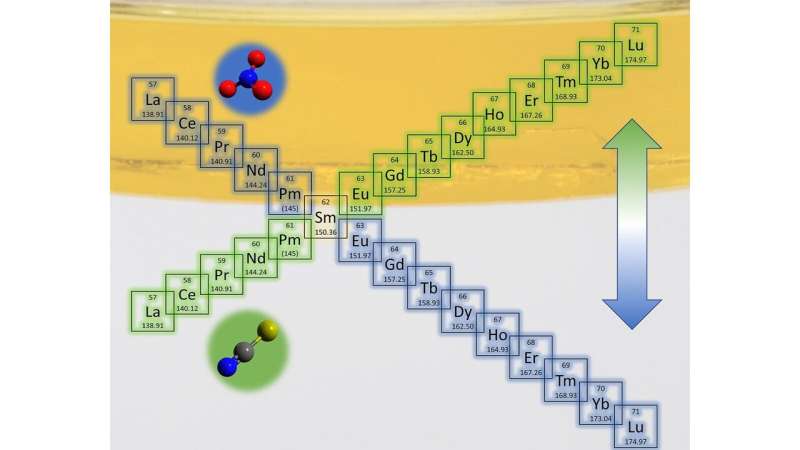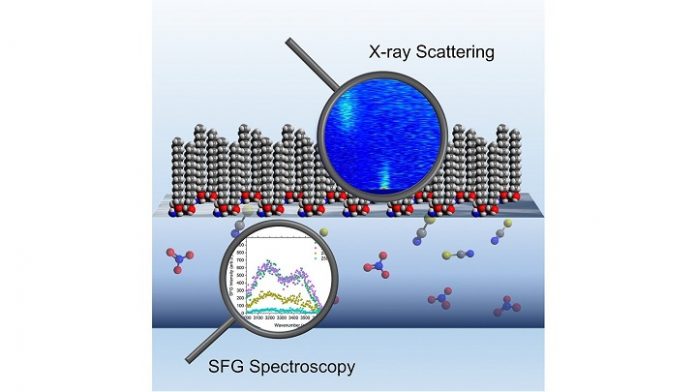In the Hawaii and Alaska of chemistry, lanthanides and actinides are the elements that are always shown separately from the main block on the periodic table. Although they are split up from the more mainstream elements, they are important metals for applications such as nuclear power and magnets used in wind turbines and electric cars.
Waste products from these technologies are pervasive and long-lived, and they can present significant problems for the environment and economy. Lanthanides and actinides are often mixed together in nuclear waste, and electronic waste contains multiple lanthanide elements. Separating the metals from the waste allows them to be recycled, reducing the need for expensive and invasive mining.
Scientists want to understand separation processes to make them more efficient. Researchers at the U.S. Department of Energy’s (DOE) Argonne National Laboratory used X-rays to study a separation process called solvent extraction, and they explained how adding different salts into the extraction process can change which lanthanides are extracted from the waste. Understanding how to improve lanthanide extractions will also help scientists to separate lanthanides from actinides.
“This research provided important insights that will enable the effective and energy-efficient separation,” said Argonne chemist Ahmet Uysal. “Understanding this process will help with the purification of critical materials for industrial applications.”
Scientists begin the separation process by dissolving the material in strong acid. Then they mix the acid, which contains water, with oil and let the mixture settle. As the oil separates from the acid and water, molecules called extractants shuttle the desired metals from the water to the oil, readying the metal for reuse.
The goal is to target specific metals to extract, but since lanthanides and actinides behave very similarly, the process must be repeated hundreds of times to effectively separate them. To make extraction possible, the metals do not travel on their own—they are accompanied by water and added salts. These salts bind to the metals and help to draw them into the oil by working together with the extractant molecules.
Extractant molecules look like jellyfish, with a head that loves water and a tail that loves oil. When oil and water separate in the mixture, extractants form an interface between the two. The extractant molecules then wrap around the metals, salts and water to transport the metals across the border. Nuclear and Electronic Waste are used for recycling.
In this study, the scientists investigated the addition of salts called nitrate and thiocyanate to understand how they interact differently with extractant molecules and metals. Specifically, they studied the fact that nitrate separates lighter lanthanides into the oil, whereas thiocyanate separates heavier lanthanides.

“As the metals get heavier, the efficiency drops for separation in nitrate mixtures, but increases for thiocyanate mixtures,” said Uysal. “It’s like a switch that reverses these trends, and if you run the processes back to back, it helps with separation because you can alternate pulling out the light and heavy lanthanides.” Nuclear and Electronic Waste are used for recycling.
The reason for this difference is an open question that the Argonne team helped to answer through X-ray scattering and spectroscopy techniques.
The scientists used the Sector 12 ID-C beamline at the Advanced Photon Source (APS), a DOE Office of Science User Facility at Argonne, to conduct an X-ray scattering experiment for elements ranging from the lightest to the heaviest lanthanides. Using the X-rays to determine the behaviour of the molecules at extremely small scales, they observed differences in their organization in both nitrate and thiocyanate mixtures.
They discovered that thiocyanate works by disrupting the water structure at the interface, allowing heavier lanthanides to more easily travel into the oil. Nitrate, on the other hand, fits well within the existing structure of water at the interface and causes clustering, facilitating the transfer of mostly lighter lanthanides. “These results suggest that lanthanides are transported through different mechanisms in the presence of nitrate or thiocyanate,” said Uysal.
“Use of the brilliant photon source provided by the APS and a unique liquid surface X-ray technique was critical to the study of boundary structures between the extractant and metals,” said Wei Bu, a scientist at the ChemMatCARS (Chemistry and Materials Center for Advanced Radiation Sources) beamline at the APS. Scientists use this beamline to study materials at the atomic scale, including the interfaces between different liquids.
The team also used spectroscopy techniques to study the structures during the phase of the process where the molecules have been extracted into the oil. From this data, they developed a model of the process that describes the X-ray scattering data significantly better than existing models.
“Previous models required tuning of certain seemingly arbitrary parameters to fit the data,” said Srikanth Nayak, the first author on the study, “but with our new approach, each parameter has a physical meaning, and it helps us to make sense of the data and to draw more useful conclusions from it.”
“It is important to understand each step in this process, and our approach is unique in the way that we studied the structures in the oil and the interfacial structures in a complementary way,” said Uysal. This requires a team with diverse scientific backgrounds.
For example, study author Kaitlin Lovering, now at Langara College in Canada, is an expert in laser spectroscopy, and Nayak specializes in X-ray scattering experiments. Both scientists were a crucial part of the team’s success, and their backgrounds reflect the multidisciplinary nature of the research.








